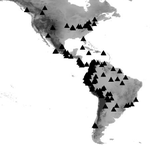Abstract
Aim To evaluate the strength of evidence for hypotheses explaining the relationship between climate and species richness in forest plots. We focused on the effect of energy availability which has been hypothesized to influence species richness: (1) via the effect of productivity on the total number of individuals (the more individuals hypothesis, MIH); (2) through the effect of temperature on metabolic rate (metabolic theory of biodiversity, MTB); or (3) by imposing climatic limits on species distributions.
Location Global.
Methods We utilized a unique ‘Gentry-style’ 370 forest plots data set comprising tree counts and individual stem measurements, covering tropical and temperate forests across all six forested continents. We analysed variation in plot species richness and species richness controlled for the number of individuals by using rarefaction. Ordinary least squares (OLS) regression and spatial regressions were used to explore the relative performance of different sets of environmental variables.
Results Species richness patterns do not differ whether we use raw number of species or number of species controlled for number of individuals, indicating that number of individuals is not the proximate driver of species richness. Productivity-related variables (actual evapotranspiration, net primary productivity, normalized difference vegetation index) perform relatively poorly as correlates of tree species richness. The best predictors of species richness consistently include the minimum temperature and precipitation values together with the annual means of these variables.
Main conclusion Across the world’s forests there is no evidence to support the MIH, and a very limited evidence for a prominent role of productivity as a driver of species richness patterns. The role of temperature is much more important, although this effect is more complex than originally assumed by the MTB. Variation in forest plot diversity appears to be mostly affected by variation in the minimum climatic values. This is consistent with the ‘climatic tolerance hypothesis’ that climatic extremes have acted as a strong constraint on species distribution and diversity.
